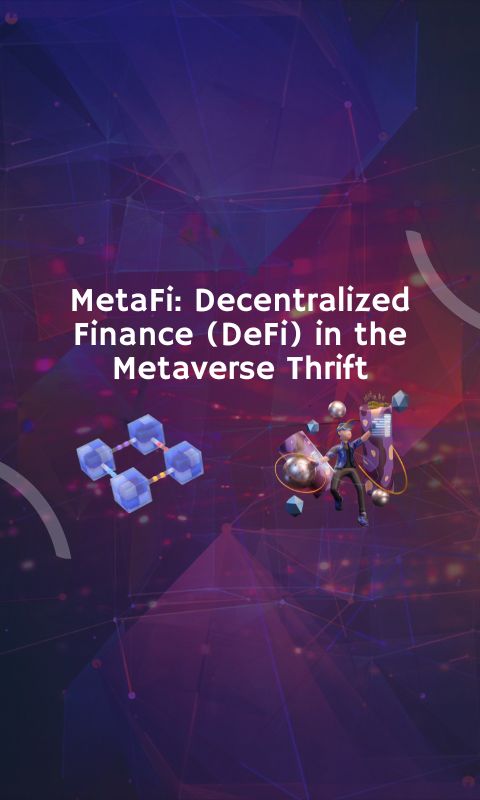Table of Contents
ToggleThe decentralized finance market (DeFi) quadrupled from less than 1 billion dollars in 2019 to 15 billion dollars in 2020. According to estimates, the need for the metaverse will grow to $783 billion by 2024. Now for some news that deserves your attention. DeFi, the metaverse, and MetaFi can combine their resources to produce a new parallel economy with great potential.
A great number of digital assets are dependent not only on platforms but also on networks that are uniquely tailored to their needs. If this problem is fixed, the guiding principles of DeFi will become more applicable across the entirety of the metaverse. This is what we hope to accomplish with MetaFi.
The standardized use of digital assets is made possible by blockchain technology and MetaFi. This makes it possible for any virtual marketplace or environment to read and filter bitcoin, financial transactions, and NFTs.
Do you still need clarification regarding MetaFi, DeFi, and the metaverse? You will gain an understanding of the principles after reading this essay.
The Thrift of DeFi and the Metaverse
The traditional, centralized banking system is coming under attack from new technologies such as virtual reality, blockchain, and algorithmic tools. Let’s take a closer look at the recent developments that have laid the groundwork for the growing decentralized economy.
Explaining the Term Decentralized Finance
The term “decentralized finance” refers to the provision of peer-to-peer (P2P) financial services through the use of publicly accessible blockchains (DeFi). Its primary purpose is to eliminate the requirement of a middleman in monetary dealings between users, including payments, loans, and currency exchanges. This will be accomplished by allowing users to engage in such activities.
Additionally, in comparison to traditional methods of financing, this new technology is intended to be more expedient and risk-free. Every monetary transaction is recorded on the blockchain, a distributed public database designed specifically for peer-to-peer dealings.
Smart contracts, computer programs that carry out transactions according to predetermined criteria, will replace traditional institutions such as banks and other regulatory bodies. Access to these Decentralized finance development company services and your digital currency can be gained through DeFi software (dApps).
Digital tokens, whether fungible or non-fungible, make up DeFi’s intended user base. Non-fungible tokens, also known as NFTs, are one-of-a-kind cryptographic assets representing various things, including ownership rights, works of art, media, and virtual products. Cryptocurrencies are fungible tokens, the majority of which are stablecoins and their various versions.
It is also possible to combine these assets. It is possible to create new financial instruments by compiling and reprogramming them. This necessitates the development of brand-new NFTs for the metaverse, which MetaFi can access within various virtual settings.
Explaining the Term Metaverse
People connect through the use of computer-generated avatars in the metaverse, which is an online virtual reality environment. Web browsers, virtual reality headsets, and augmented reality technology are the primary entry points for accessing it.
Nevertheless, it goes beyond the realm of virtual reality. It comprises programmable “smart contracts,” a distributed peer-to-peer ledger, and digital tokens (cryptocurrency, NFTs, and derivatives).
Importantly, the metaverse and DeFi may collaborate to build an economic system that is both just and entertaining for everyone involved.
What is the relationship between DeFi and the metaverse?
- Customers, sellers, digital artists, and businesses were all given a wealth of potential by introducing DeFi for the metaverse.
- As a result of the increased number of users who can create and trade NFTs and cryptocurrencies, markets will be able to broaden their customer base by hosting their platforms within various virtual worlds.
- The ability to build, market, and sell virtual homes, land, islands, and other sorts of property is made available to investors.
- Digital artists can produce various items for users of the metaverse, including wearable devices, avatars, and other assets.
- The option to lend out unique in-game objects to other players is available to yield farmers in exchange for a portion of their overall income or a set fee.
- Businesses that deal in art now have more opportunities to sell their wares, including the ability to host NFT galleries and auctions.
- Players are rewarded for participating in metaverse games through the play-to-earn mechanic, which enables them to obtain a variety of tokens.
- To provide its consumers with access to VIP communities, restricted virtual worlds or material, or voting rights for club decisions, companies regularly generate fan (access) tokens.
That does seem strange, that’s for sure. It is necessary for MetaFi to triumph over a challenge before we will have a complete understanding of the metaverse potential of DeFi.
The Problem of DeFi and Compatibility with Metaverses
The most significant obstacle that DeFi faces is interoperability or the need for standards. The development of effective blockchain frameworks is essential to the further progress of the technology (primarily on Ethereum).
All decentralized applications, cryptocurrencies, and digital assets are built on these frameworks, each with its ecosystems and shared application logic.
Applications and tokens developed for one framework will not operate with another. Because their value depends on specific platforms, they cannot participate in the decentralized economy.
The metaverse has the same problem as other virtual universes because it is built with various technological stacks but still consists of many different virtual realities. Your digital assets will not function properly across different platforms and will have no value if interoperability cannot be achieved.
The metaverse must be interoperable to put into practice the DeFi principles and make it possible for tokens to be used in multiple virtual worlds. MetaFi could be the solution.
How MetaFi defines DeFi standards for the metaverse
To make cryptocurrencies, non-fungible tokens, and the derivatives of those assets more accessible throughout the metaverse, MetaFi has standardized them all. The metadata data within blockchains are mined to determine structural, statistical, descriptive, and legal information relating to digital assets.
In most cases, the image, video, or audio file that corresponds to the metadata of the NFT is also connected to it. Transactions in Bitcoin can also have metadata attached to them, which makes them more easily sortable and readable by machines.
When MetaFi standards are apply to DeFi and the metaverse, digital assets can be accessed on various blockchain frameworks and platforms. Users of the metaverse and innovative businesses both stand to gain from this in multiple ways.
Final Words
The decentralized finance of the metaverse has the potential to be made more user-friendly, accessible, and interesting with the help of DeFi. However, the largest challenge they face now is interoperability, which they must overcome.
This problem, which affect both DeFi and the metaverse, has been fixed by MetaFi. This technology has the potential to standardize digital assets, making it possible for bitcoin and other non-fungible tokens to function in several different blockchain networks and virtual worlds.








